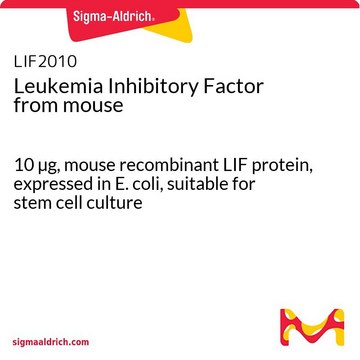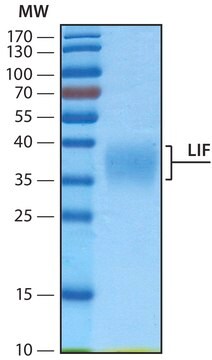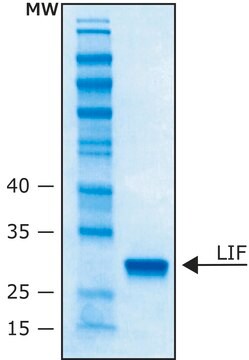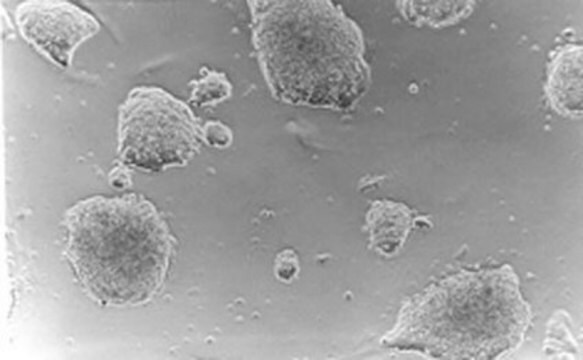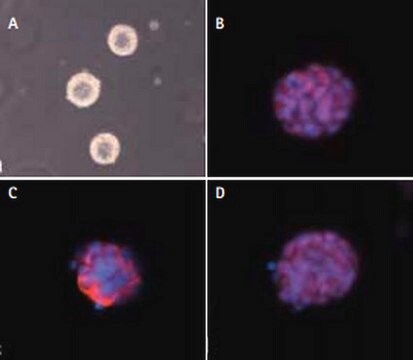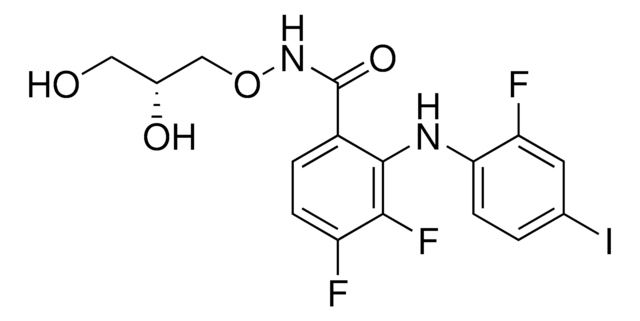추천 제품
product name
Leukemia Inhibitory Factor from mouse, LIF, recombinant, expressed in E. coli, 10 μg/ml, buffered aqueous solution, suitable for cell culture
재조합
expressed in E. coli
Quality Level
분석
≥95% (SDS-PAGE)
형태
buffered aqueous solution
품질
endotoxin tested
기술
cell culture | mammalian: suitable
저장 온도
2-8°C
유사한 제품을 찾으십니까? 방문 제품 비교 안내
애플리케이션
Leukemia Inhibitory Factor from mouse has been used:
- as a component of enriched co-culture media
- as a supplement in Dulbecco′s modified eagle′s medium (DMEM)/F12 medium for culturing heart cells
- as a component in maintenance medium for maintaining embryonic stem cells
- to treat ovaries in ovarian culture
생화학적/생리학적 작용
Leukemia Inhibitory Factor (LIF) is a pleiotropic glycoprotein originally described to inhibit the proliferation of the murine myeloid leukemic cell line M1, while inducing differentiation into macrophages. Other activities were later identified to LIF, which is known by a variety of synonyms, including DIF, D-factor, DIA, DRF, CNDF, HILDA, HSF-III, and MLPLI. Human LIF exerts its actions through a receptor comprising a 190 kDa LIF-binding α-chain (130 kDa, mouse) and a 130 kDa signal-transducing β-chain (gp130), which is shared with CNTF, OSM, L-6 and IL-11. As such, it is a member of the gp130 family of the cytokine receptor superfamily. LIF receptors have been identified on several cells, including monocytes, liver, placenta and embryonic stem cells. Natural LIF is heavily glycosylated, showing an apparent molecular weight of 32 kDa to 62 kDa, depending on the source, but absence of glycosylation appears not to affect its biological activity. A single gene encodes LIF, which is secreted as a single chain glycoprotein containing 180 amino acids for human or mouse with a conserved disulfide bond. Human and mouse LIF share 78% sequence homology. Human LIF can activate mouse cells, but mouse LIF cannot activate human cells.
물리적 형태
Solution in phosphate buffered saline containing 0.02% TWEEN® 20
분석 메모
The proliferative activity of mouse LIF is measured in culture using the M1 murine cell line.
법적 정보
TWEEN is a registered trademark of Croda International PLC
Storage Class Code
11 - Combustible Solids
WGK
WGK 3
Flash Point (°F)
Not applicable
Flash Point (°C)
Not applicable
개인 보호 장비
Eyeshields, Gloves, type N95 (US)
시험 성적서(COA)
제품의 로트/배치 번호를 입력하여 시험 성적서(COA)을 검색하십시오. 로트 및 배치 번호는 제품 라벨에 있는 ‘로트’ 또는 ‘배치’라는 용어 뒤에서 찾을 수 있습니다.
이미 열람한 고객
LIF-immobilized nonwoven polyester fabrics for cultivation of murine embryonic stem cells
Cetinkaya G, et al.
Journal of Biomedical Materials Research Part A, 81(4), 911-919 (2007)
C-Kit Positive Cardiac Stem Cells and Bone Marrow-Derived Mesenchymal Stem Cells Synergistically Enhance Angiogenesis and Improve Cardiac Function After Myocardial Infarction in a Paracrine Manner
Bao L, et al.
Journal of Cardiac Failure, 23(5), 403-415 (2017)
Renée F de Pooter et al.
Methods in molecular biology (Clifton, N.J.), 290, 135-147 (2004-09-14)
Lymphocytes arise during ontogeny via a series of increasingly restricted intermediates. Initially, the mesoderm gives rise to hemangioblasts, which can differentiate into endothelial precursors, or hematopoietic stem cells (HSCs). HSCs can either self-renew or differentiate into lineage-restricted progenitors and, ultimately
Suppressor of cytokine signaling 4 (SOCS4): moderator of ovarian primordial follicle activation
Sutherland JM, et al.
Journal of Cellular Physiology, 227(3), 1188-1198 (2012)
D P Gearing et al.
The EMBO journal, 6(13), 3995-4002 (1987-12-20)
Leukaemia inhibitory factor (LIF) can induce macrophage differentiation in M1 murine myeloid leukaemic cells and suppress their proliferation in vitro. It does not stimulate the proliferation of normal progenitor cells and is apparently distinct from known colony-stimulating factors. We have
자사의 과학자팀은 생명 과학, 재료 과학, 화학 합성, 크로마토그래피, 분석 및 기타 많은 영역을 포함한 모든 과학 분야에 경험이 있습니다..
고객지원팀으로 연락바랍니다.